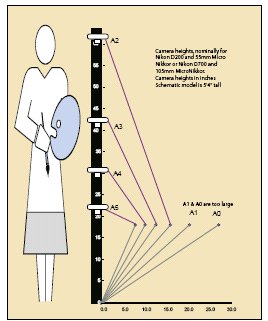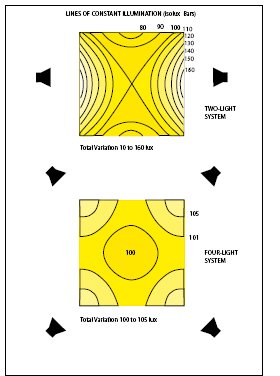articles/Fine-art/creativereproduction-page3
Fine Art & Creation Reproduction - part 3 of 1 2 3 4 5 6 7 8
by Mike McNamee Published 01/10/2011

Reproducing Fine Art - essential skills
Making perfect facsimiles of art is not the straightforward task that is sometimes assumed. Geometrics is vital and this includes both that of the lens design and the camera-subject alignment. The 'drawing' of a lens is little discussed today; it used to be of great importance when 'repro' lenses had to accurately reproduce both artwork (for printing) and masters for printed circuit-board production. Process lenses had the best drawing, followed by macro lenses, prime lenses and then zooms. This is because 'distortion' is one of the seven so-called Siedel aberrations of lens design (more commonly known are chromatic aberration and astigmatism) which impose constraints on lens design such that accuracy of drawing has to be optimised (or compromised) with other characteristics such as wide aperture and zoom range. For this reason, older, manual focus macro lenses of simple design often provide the best reproduction. The archetypal design in this regard is the 6-element Double Gauss Nikkor variant found on the 55mm f2.8 MicroNikkor. The problem of getting hold of one of these is that those of us who have them will never sell them to you! As a lens to attach to a 35mm size of camera this optic has rarely been surpassed (although a 75mm f4.0 Enlarging Nikkor runs it very close!).

Reproducing Fine Art - essential skills
Making perfect facsimiles of art is not the straightforward task that is sometimes assumed. Geometrics is vital and this includes both that of the lens design and the camera-subject alignment. The 'drawing' of a lens is little discussed today; it used to be of great importance when 'repro' lenses had to accurately reproduce both artwork (for printing) and masters for printed circuit-board production. Process lenses had the best drawing, followed by macro lenses, prime lenses and then zooms. This is because 'distortion' is one of the seven so-called Siedel aberrations of lens design (more commonly known are chromatic aberration and astigmatism) which impose constraints on lens design such that accuracy of drawing has to be optimised (or compromised) with other characteristics such as wide aperture and zoom range. For this reason, older, manual focus macro lenses of simple design often provide the best reproduction. The archetypal design in this regard is the 6-element Double Gauss Nikkor variant found on the 55mm f2.8 MicroNikkor. The problem of getting hold of one of these is that those of us who have them will never sell them to you! As a lens to attach to a 35mm size of camera this optic has rarely been surpassed (although a 75mm f4.0 Enlarging Nikkor runs it very close!).
Today, there are many tools at the photographer's disposal for dealing with residual distortion even though it is a compromise compared to getting it right at the taking stage. Adobe Camera RAW has corrections for pincushion, barrelling, key stoning, rotation and scale. Photoshop has the Warp tool (in extremis!) along with a set of linear distortion tools. All distortion corrections carry a penalty in terms of resolution and should be used with discretion, followed by careful, appropriate sharpening. As with all things digital you also have options for stitching multiple images together to enhance the working resolution of your camera or scanned image.
Lighting and Exposure
Calculations show that the most effective form of lighting is the use of four lamps arranged on each corner of the working area, on the diagonals from the centre of the artwork. They should be placed as far away as practical to provide more even illumination. The lens aperture should be chosen for maximum resolution (usually f5.6 or f8) and the shutter speed adjusted accordingly. It is taken as read that a heavy tripod is employed but for regular work a more substantial bespoke rail system would be better. The light sources need to be balanced for output, a process that may take quite a long time (tens of minutes at least!). Avoid soft boxes, for although the light may be more even, it will have less contrast and reflections are more difficult to control. Flash provides a cooler environment but is trickier to set up
If an original has to be left in its glazed frame your problems are compounded by the presence of the glass. This will reflect anything in the room, change the colour temperature of the subject and reduce the image contrast. However, there are serious implications to removing an original from its frame and this should not be done without consulting the owner and taking advice if necessary. Insurance also raises its head here, as the risk of damage is increased. For the same reason, if the camera is to be located directly above the artwork it should be set up with a substitute, same-size target and the original only brought to the table when the camera is secured and locked in place (and don't forget to tape the lens hood on as well!). The blow from a camera falling onto an original has rarely been found to improve it! For the same reason, liquids and food should be banished from the working area. Watercolour art is usually reproduced by scanning as it is unlikely to be damaged by careful contact with the platen, for the same reason though, acrylic with heavy impasto is certain to need photographic repro rather than scanning, as is collage (see call out on handling impasto brush work).
Please Note:
There is more than one page for this Article.
You are currently on page 3
- Fine Art & Creation Reproduction page 1
- Fine Art & Creation Reproduction page 2
- Fine Art & Creation Reproduction page 3
- Fine Art & Creation Reproduction page 4
- Fine Art & Creation Reproduction page 5
- Fine Art & Creation Reproduction page 6
- Fine Art & Creation Reproduction page 7
- Fine Art & Creation Reproduction page 8
1st Published 01/10/2011
last update 21/07/2022 08:46:23
More Fine-art Articles
There are 20 days to get ready for The Society of Photographers Convention and Trade Show at The Novotel London West, Hammersmith ...
which starts on Wednesday 14th January 2026










